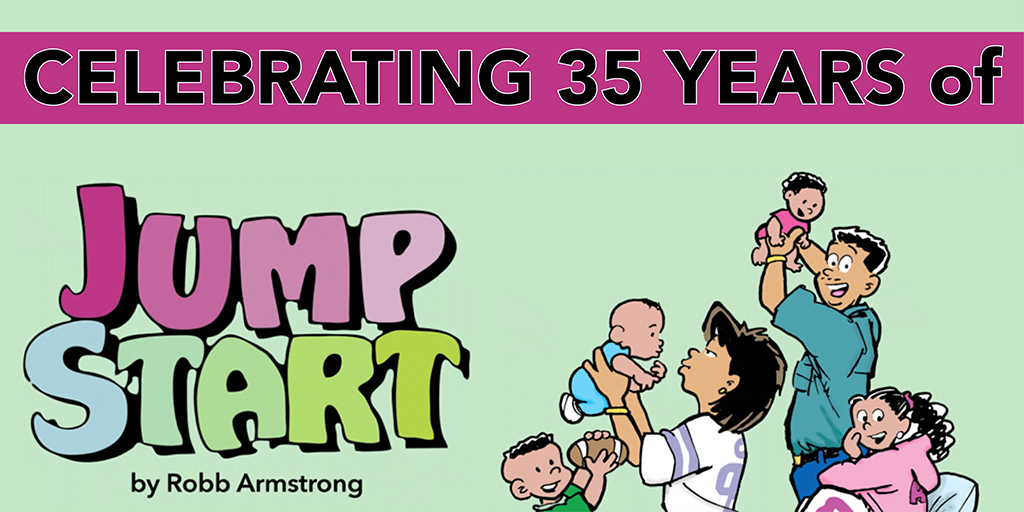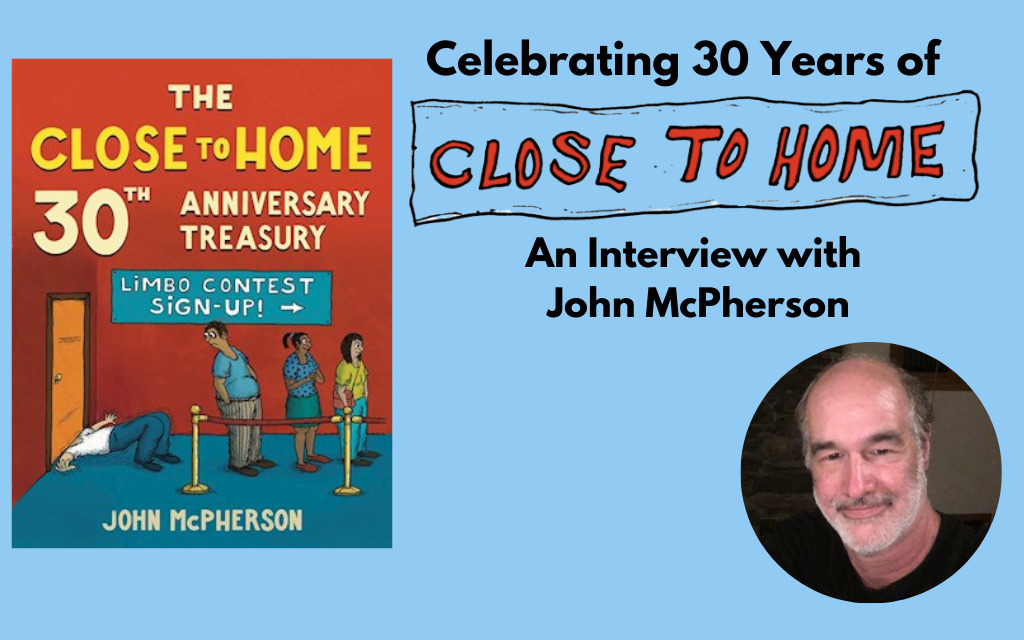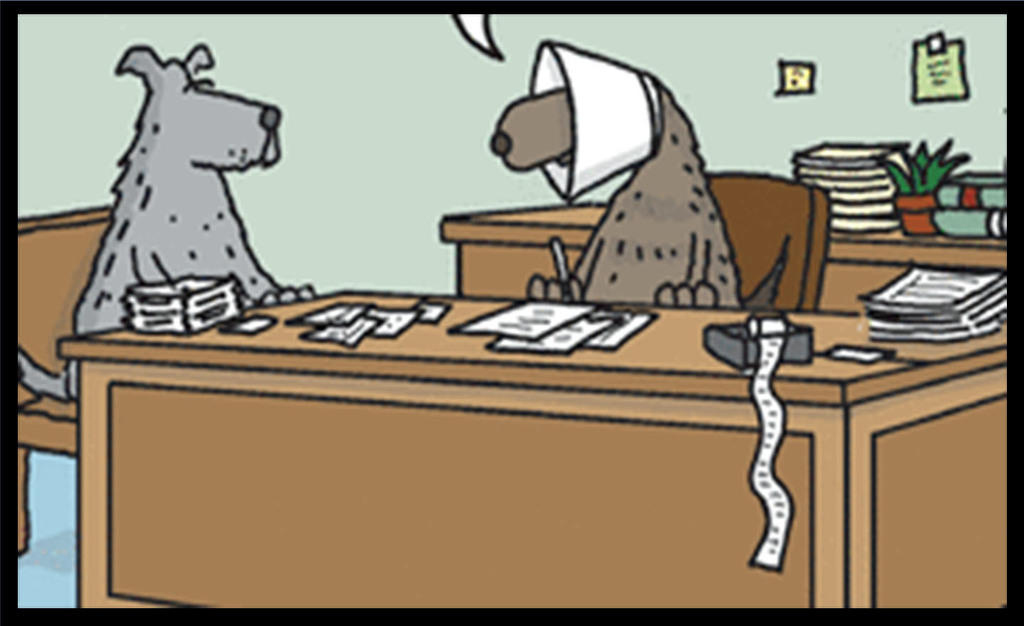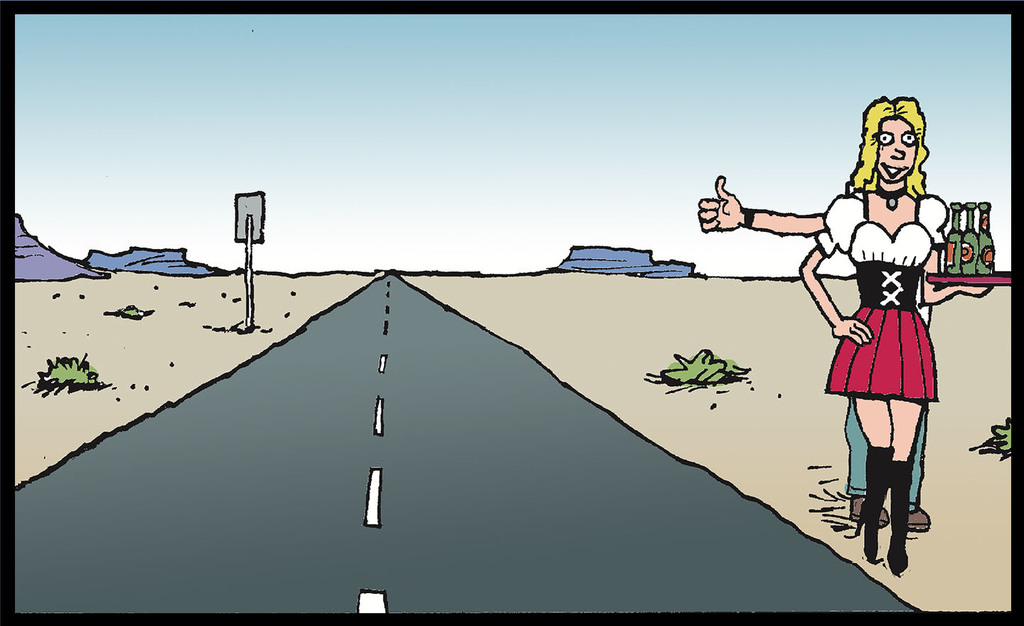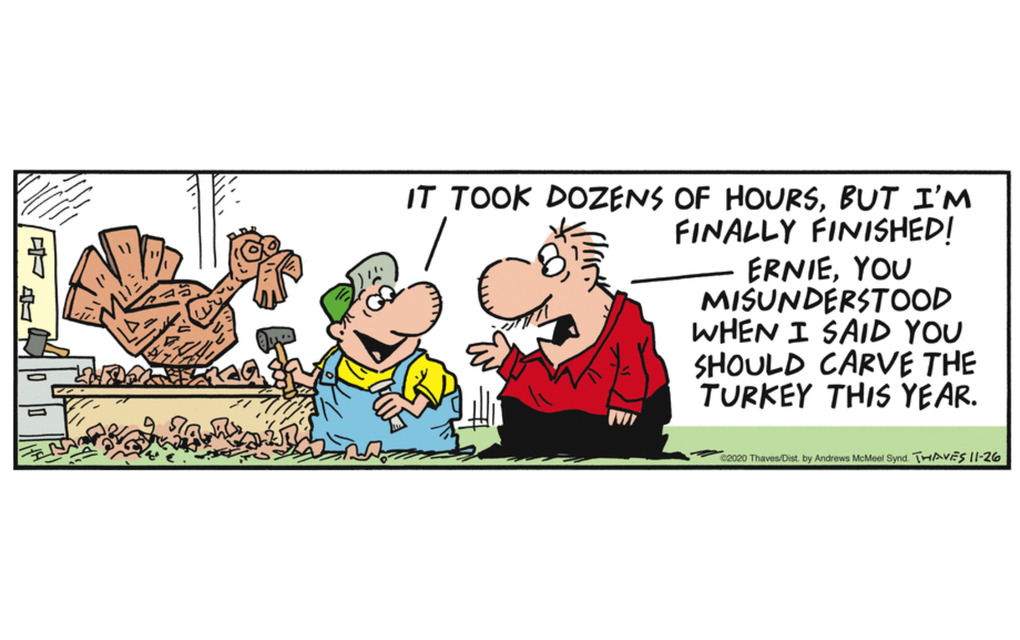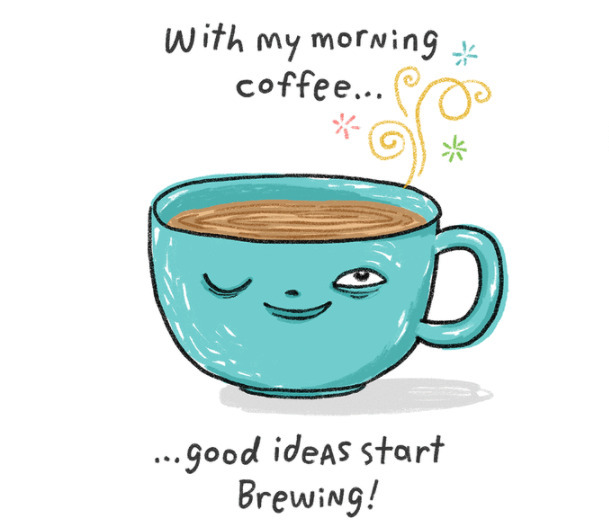Scott Nickel (EEK!)
by GoComicsThe GoComics "Meet Your Creator" series brings you firsthand insight into the lives and careers of your favorite cartoonists. Each week, we hand over the keys to one of our talented creators, who share their inspirations, achievements, creative processes, studios and more! Read on to hear from this week's featured cartoonist: Scott Nickel of EEK!
A few years back, I interviewed a bunch of cartoonists on my blog, A Nickel's Worth, asking each cartoonist 20 questions. I thought it would be fun to give myself the same treatment.
1. When you were a kid, did you want to be a cartoonist? Did you draw?
I was born with a pencil in my hand, which must have been painful for my mother! Cartooning and humor have been lifelong interests, and I have memories of looking at Marvel's Not Brand Echh comic book and MAD Magazine and just soaking them up like a sponge. My first illustrated story was a true-life tale of breaking my arm when I was five. I could already read fairly well and I spelled everything phonetically.
Influenced by a steady diet of monster movies and black-and-white horror magazines (Creepy, Eerie, Psycho and Nightmare), I continued to draw, creating my own comics (for an anthology titled Tales to Astonish), which I drew first on newsprint and then on heavier 11 x 14 drawing paper. I stapled each issue and included a cover price (75 cents!). I wrote and drew wonderfully derivative horror-themed stories and adapted a few Universal movies (The Wolf Man and House of Frankenstein.)
When I was 12, I tackled Mary Shelley's iconic Frankenstein novel and ended up drawing a 136-page adaptation over the course of a year and a half. It was a huge job and I'm amazed at my perseverance and work ethic at such a young age. It was a real labor of love and I still have the pages, along with the other comics I created as a kid.
2. What was your first paying cartoon job?
Technically, I think it was a series of illustrations I did at the end of my senior year in high school for a science textbook (I pulled in a cool $9.78 per drawing). I also drew posters for the dining hall in college and illustrated a hang-glider brochure. Such auspicious beginnings! My first real paying cartoon jobs came in the mid-1980s with work for Last Gasp!, Rip-Off Press and Fantagraphics.
3. Tell us how you developed your GoComics strip, EEK!
Ah, I remember it well ... it was a dark and stormy night. After a two-year stint as a syndicated cartoonist on King Features' Triple Take comic (written by the terrifically talented Todd Clark), I was itching to do a strip of my own. Remembering the sage advice that the best creations come from within, I tapped my jugular vein and out flowed EEK! My rabid interest in monsters, movies, and MAD-style humor helped the gags flow naturally.
Hey, they may not all be great, but they come from a very pure place. I submitted the strip to the newspaper syndicates and then to Universal UClick, which accepted the feature for GoComics. That was in 2007, and I've been producing the strip three times a week ever since. Some of my favorite strips are the ones with the brain in a jar and the Grim Reaper. And, of course, Frankenstein. Boris Karloff's Frankenstein is my all-time favorite movie monster, so I try to put Frankie (and his Bride) in the strip as often as possible.
4. You're also a writer; how does that compare to cartooning?
For one thing, it's a lot faster. It's also easier, in a way. I've written a jillion humorous greeting cards and T-shirt slogans and I find it very satisfying. I can churn out a lot of material in a pretty short time. I've written several graphic novels and contributed scripts to the Garfield comic book, and I can bang out a script in a fraction of the time it would take to illustrate. Plus, I get to write all the crazy stuff I could NEVER draw. And I get to work with amazing artists like Gary Barker, Andy Hirsch, David DeGrand, Genevieve FT and the inimitable Roger Langridge (to name just a few).
5. What's your favorite rejected gag?
I submitted this to everyone, but it never sold: Two babies are sitting on the floor, talking. One says to the other, "It's so hard to lose the fat without a good cardio program."
6. Why is the single-panel superior to the comic strip?
As the Bard wrote, "Brevity is the soul of wit." OK, my less pretentious answer is this: I'd spent years trying to get a syndicated comic strip, with not much success. Then in 2007, I started submitting single-panel gag cartoons to magazines. Magazine cartooning isn't exactly a growth industry these days, but to my surprise and delight, I started selling cartoons. And to major markets, too: Reader's Digest, Woman's World, The Sun, The Wall Street Journal, Physician's Weekly, The Harvard Business Review, Boys' Life. EEK! is essentially a single-panel gag cartoon in a horizontal "strip" format.
For whatever reasons, single-panel gags just come more naturally to me. It's essentially two different approaches to humor: I've heard it described as stand-up comedy versus situation comedy. Just call me "Shecky" Nickel.
7. You've contributed fairly regularly to MAD Magazine. How does it feel to be one of the Usual Gang of Idiots?
Getting into MAD was a childhood fantasy come true. The MAD I contribute to today isn't quite the same as the classic MAD I grew up with, which featured the work of legendary superstars like Mort Drucker, Jack Davis, Al Jaffee, Frank Jacobs, Angelo Torres, Paul Coker Jr. and a host of other greats. But hey, it's still MAD, and I'm proud to be considered one of the Gang. My proudest moment was creating "Projectile Vomit Baby," MAD's grossest comic strip.
8. Name five of your favorite cartoonists.
Five of about a zillion: Al Jaffee, Gary Larson, Charles Schulz, Sergio Aragones, Glenn McCoy.
9. Who'd win in a cage match, Hagar the Horrible or Blondie?
Hagar has brute strength going for him, but Blondie has that killer instinct. Don't let that sweet suburbanite act fool you. She can snap a man's neck without even breaking a sweat.
10. How do you develop ideas? Which comes first, words or pictures?
Many times, they'll happen at the same time "о a quick sketch with a gag (invariable with handwriting I can barely decipher later). Sometimes, it's words first; just for fun I like to draw something weird and then come up with different gags/captions. It's kind of freeing and can lead to unusual results.
11. Do you ever worry about running out of ideas?
I used to, but now I trust that they'll keep coming. You just need to relax and let 'em.
12. What's more important, raw talent or perseverance?
I'm living proof that a thimbleful of talent and a bucketload of perseverance can pay off. My experience is that the most successful people have talent, but also work very, very hard.
13. Tell us about your day job at the Garfield studio.
I'd like to, but if I did, I'd have to kill you. Jim Davis runs a very tight ship. But you can visit the Garfield website here.
14. What are your favorite books, TV shows, songs and films? (Yes, that counts as one question.)
Books: Of Mice and Men, 1984, A Farewell to Arms and Andre Dubus' novellas.
TV shows: Mad Men (season 1), Breaking Bad (seasons 1 and 2), Mr. Show, South Park, Mr. Robot, General Hospital.
Movies: Bride of Frankenstein, Memento, Double Indemnity, The Heartbreak Kid (1972).
Music: Springsteen, Barenaked Ladies, '70s soft rock, Dark Polka.
15. What are your tools of the trade and what's your workspace like?
I sketch my strips and cartoons on typing paper, and then use a light box to ink. I ink my EEK! strips with Micron pens on Strathmore Bristol Board. Many of my gag cartoons and greeting cards are inked on the light box on typing paper. My art table is the same one I've had since I was 11. My mom bought it for me from a local drafting store in L.A. It's a great table and hopefully the only one I'll ever need to buy. Once I've inked the art, I scan it into Photoshop where I add lettering and color. I use the American Color swatches for newspaper comics as my main color palette. I like the bright colors that exclude black from the mix.
My workspace? Frankly, it's a mess. A huge mess. The president needs to declare my office a national disaster area and call in FEMA. I look at the work areas of other cartoonists and marvel at their uncluttered tables, their clean desks and organized shelves. By contrast, I work in a veritable landfill. In fact, my office is such a horrific mess that the only picture you'll see is one so severely cropped that it basically shows nothing. But trust me. Just lurking out of frame is a scene that would make the producers of Hoarders shriek in terror.
16. Name the five biggest influences on your work.
MAD Magazine, Universal Monsters, National Lampoon, The Simpsons, Stan Lee.
17. Have you met any of your cartoonist idols? Under what circumstances?
I met Sergio Aragones through a cartoonist group in California; great guy! Met Neal Adams at the Indy show. I corresponded with Al Jaffee through email and had him sign a Garfield cover he drew. And, of course, I work for Jim Davis, so that's pretty cool.
18. What advice would you give aspiring cartoonists?
To borrow a line from cartoonist Gary Barker, "Stop aspiring! It'll leave stains!" Truthfully, I can't offer much advice, except if you love cartooning, keep at it. Whether it's comics, cartoons, animation, or whatever, find an outlet and keep doing it. The more you cartoon, the better you'll get. Except me. I've pretty much peaked, obviously.
19. Do you go to conventions or shows?
Not usually (I have the social proclivity of a Galapagos tortoise), but I did have a table at the Wizard World show in Indianapolis this year, and I'll be a guest at the North Texas Comic Book Show in Dallas on November 14. Come by and say hello!
20. What's something that nobody knows about you?
I'm Batman.


